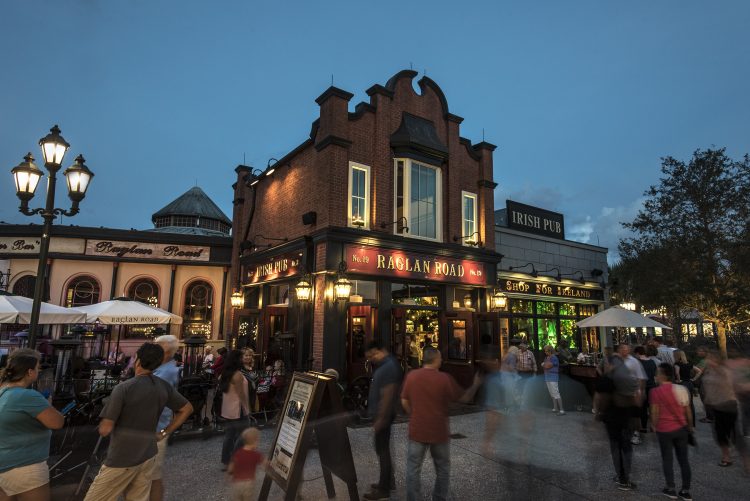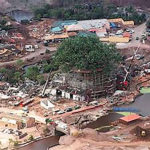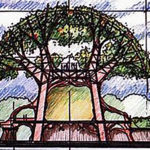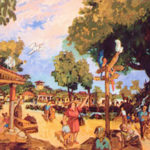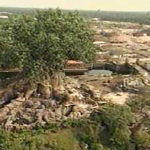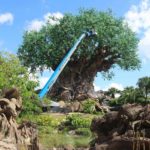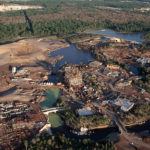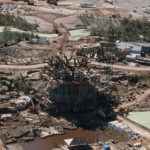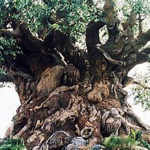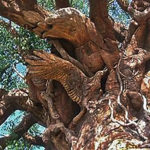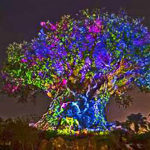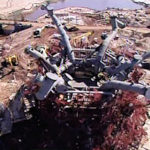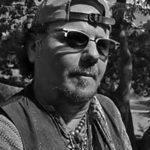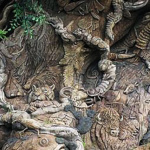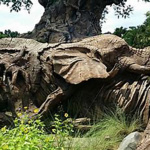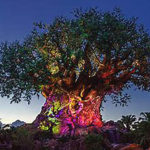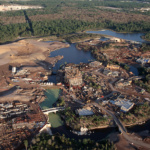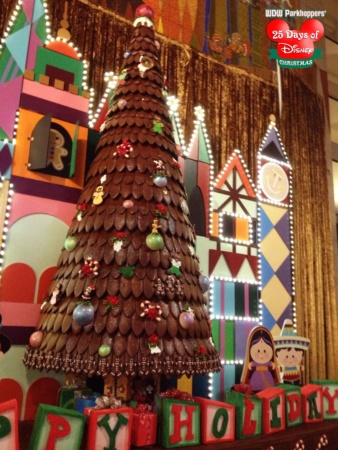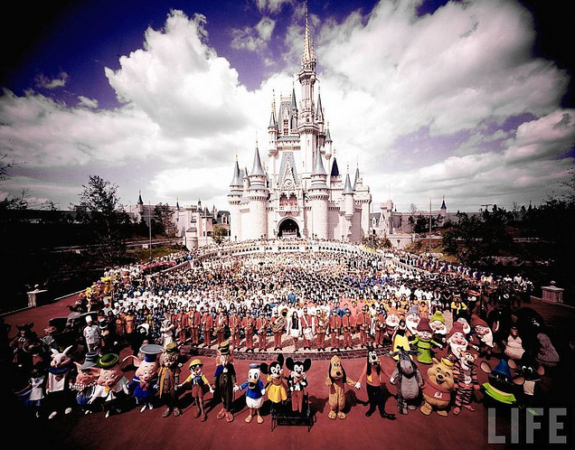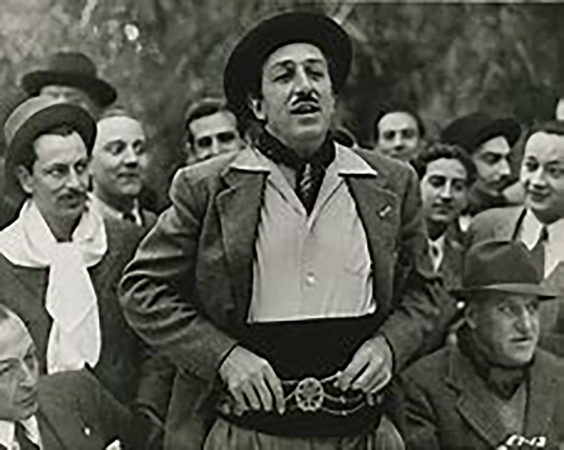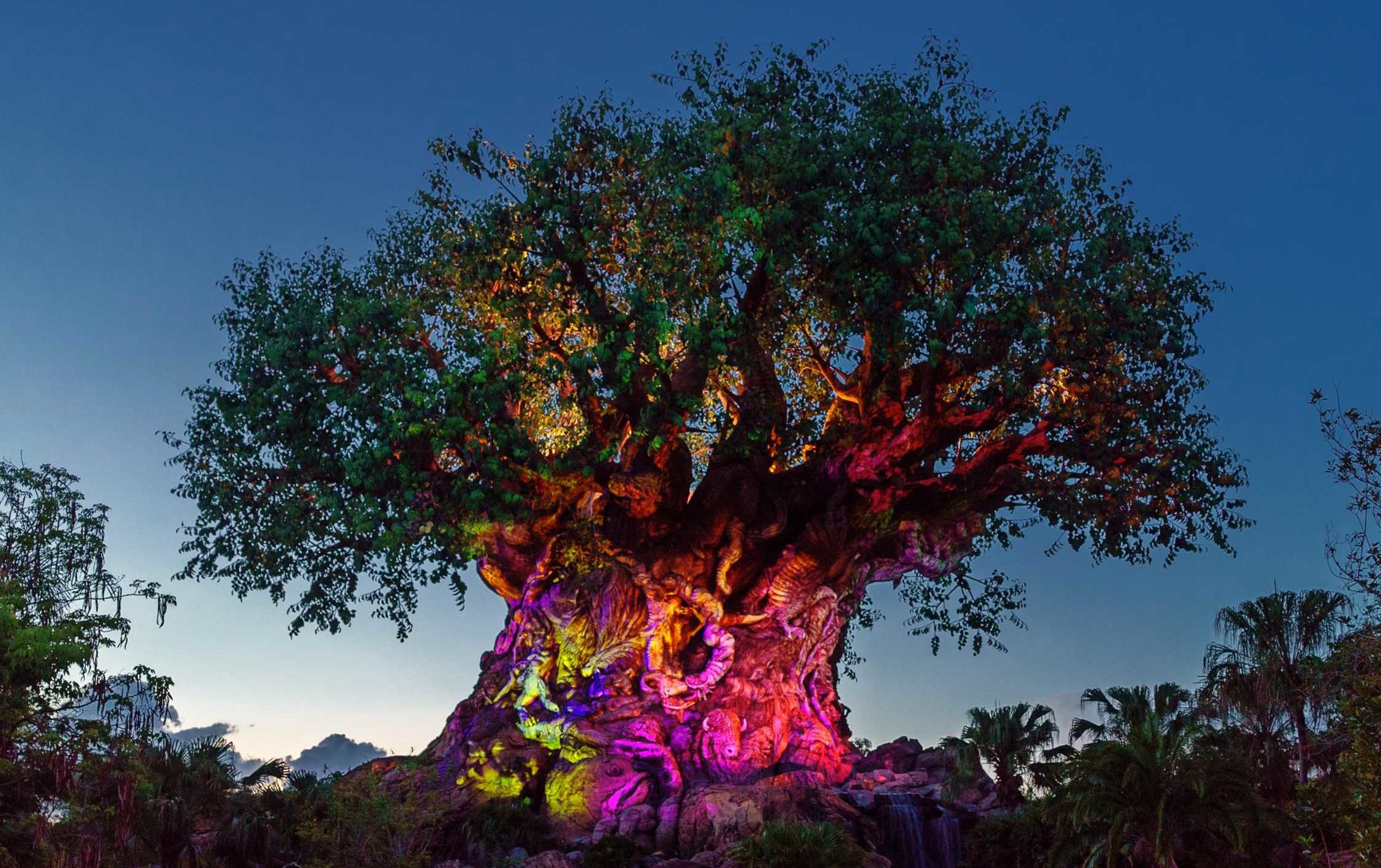
Animal Kingdom’s “Tree of Life”…
Walt Disney was a talented individual, who wore many hats, and was possessed with the gift insight, he just seemed to know what would work and how to embellish upon it. He was perhaps also one of the world’s greatest showman, because he knew just how to stage his product to the people. Walt always believed in a central platform, what he called a “Weenie” He came up with this moniker because arriving home late, he would sometimes grab a hotdog (Weenie) for a snack, and his dog Lady would follow him around, because she knew he would share it with her. When envisioning Disneyland, he recalled how he could lead his dog around with it, and he coined the term “weenie” to entice his guests to the many attractions he had planned.
Today, we associate Walt’s coined word, “weenie” with the term Icon. We all know the famous Disney “Icons”. The first was of course Disneyland’s’ Sleeping Beauty Castle . In Walt Disney World, Cinderella Castle is its sister Icon. Disney’s Hollywood Studios first had the Chinese Theater, then the Sorcerer’s Hat, and now, debate will show many guests believe that the Tower of Terror is the icon, others firmly believe that the Chinese Theater is. EPCOT of course has Spaceship Earth, and Animal Kingdom has the Tree of Life.
At first glance, the Tree of Life would appear as a large tree, and many would think that it is a simple structure compared to say, Spaceship Earth. Nothing could be further from the truth. Joe Rohde, Walt Disney Imagineering Vice President and executive designer of the park stated…”The Tree of Life is a technological marvel, but it’s also a symbol of the beauty and diversity and the grandeur of our animal life on Earth,”. “It’s a celebration of our emotions about animals and their habitats” Indeed the tree of Life was perhaps one of the Imagineers greatest challenges to date. The Tree of Life is based on the form of the Baobob trees in Africa. The Baobob is a succulent, which means that during the rainy season it absorbs and stores water in its vast trunk, enabling it to produce a nutrient-dense fruit in the dry season when all around is dry and arid. This is why the native inhabitant’s legends considered it “The Tree of Life”.
The greatest task in the trees construction is that it has to withstand Florida’s hurricane-force winds, it also has to look and sway in the wind, as a real tree would. Both of these challenges were overcome as only Disney’s Imagineers could do it. It must be noted that the tree first envisioned was to be about 50 feet high and serve as a playground. Other ideas included a tall viewing platform that guests could overlook the then named Safari Village, now Discovery Island. The problem for a larger tree was that it would be a bigger problem to endure hurricane strength winds, and that meant a huge foundation base must be constructed. In addition, a Restaurant to be named “Roots Restaurant” was to be placed inside the trunk of the tree, and this idea morphed into the now famous theatrical show, “It’s a Bug’s Life” The idea of a large cavernous room inside this proposed tree, and the engineering problem to support it seemed insurmountable.
Much like the idea of a ride system for Soarin’ came to an Imagineer using an erector set, an Imagineer watching a TV show about off-shore drilling rigs, realized that the construction of these rigs provided the answer Disney was looking for. The base of the structure was huge and stable, providing the room for a theater, and also afforded the stability for the rest of the tree. The next obstacle was realism. The tree had to look and react as a real tree would in nature. At first it was thought the limbs would be made of ridged steel, but after several models built, it was strong, but lacked any natural appeal. The Imagineers developed molded fiberglass branches, from about 2 feet to 2 inches, extremely strong, but would move naturally in the wind. A giant expansion joint girdles each branch unit. Special attachment “Balls” were developed as attachment points for the main branches, and from these were attached smaller, tertiary limbs. And these could be attached in a random pattern as in nature. Imagineers developed an exceptional fabrication system and assembling technique to ensure a natural, life-like appearance. The leaves were also specially made, about a foot long, in five shades of green, and they move naturally in the wind. All in all, the tree stands 145 feet tall, 165 feet across and consists of 45 secondary branches leading to 756 tertiary branches leading to 7,891 end branches with 102,583 green leaves. And let’s not forget the 430 seat 3D theater inside the trunk of this marvel of magic and construction.
However, as much of an engineering marvel the tree structure is, the actual magic so to speak, is in the astounding animal carvings in the trunk. Over 320 life-like images of animals are sculpted in the roots and trunk, and have to be seen to appreciate the skill that went into creating them. The man behind these works of art are Tree of Life chief sculptor and senior production designer Zsolt Hormay. Zsolt stated…”We want our visitors to wander up to the tree, to recognize animals and seek out others” “Some are more recognizable, some are less so. It’s a constant discovery and rediscovery.” Hormay, is a highly skilled and world-renowned expert in the design, creation and construction of themed environments for theme parks, resorts, zoo exhibits, and other venues. Hormay, a native of Budapest led an army of 20 artists, quipped… “That was probably the most difficult part of sculpting the tree, to create the 350 animal figures that appear to be formed of bark and wood — finding the balance between the animal forms and the wood textures was a great challenge,” His team consisted of three Native American artists, (Parker Boyiddle, Craig Goseyun, Arthur Rowlodge), an artist from Ireland (Vinnie Byrne) France, (Fabrice Kennel) Indianapolis (Roger White) and here in central Florida 5 Floridians, (Eric Kovach, Steve Hunke, Joe Welborn, Gary Bondurant, and Jacob Eaddy). Joe Rohde added…”This is the most impressive artistic and engineering feat that we have achieved since the original Sleeping Beauty castle at Disneyland,”
To begin this daunting task, first a model of the Tree of Life was created, with no figures in it. The model was then sectioned off into 4” by 4” pieces. A special computer-driven stylus then ran across all these dimensions, and the information was placed in a special rebar forming machine that morphed the sections into life size proportions. It took 12 weeks to weld the rebar onto the trunk of the Tree of Life. Next, Hormay and his crew directed the covering of the tree with a lattice like metal lath, the way they used to form plaster walls in homes. With scaffolding surrounding the tree, sections of the tree had a layer of special plaster like mortar applied, 2 to 4 inches deep. The artists had only about 7 hours working time to carve the animals in each section before it hardened. To insure a life-like look and appearance, coloring and texture was a major consideration. Production designer Ron Esposito stated… “People might look at the trunk and they might think, ‘It’s just brown bark’ but it’s more complicated than that”. Zsolt added… “The sculptors met every morning, studying a pile of wood for reference. They would discuss what each branch should be; a banyan, an emerging oak, a touch of cedar.” Samples of each wood were nearby for the artists to study. Esposito continued… “We used 50 to 60 color values to reveal the animals while maintaining naturalism. The tree has a dry side and a wet side, five different moss colors, multiple lichen colors as well as brown tones, overtones, and shadow tones.
The artists that sculpted the animals tried to work between a balance of structure and creativity. Design took precedence over correctness. Each figure appears to flow seamlessly into another, a root became a snake, a branch an elephant’s trunk. The objective was to have one form lead into another, not depict the animals true to size. The artists wanted to have the appearance of resulted naturally during the growth of the Tree.
As will all Disney, there is a backstory to the Tree of Life. At one time, nothing would grow on Discovery Island, it was barren of all vegetation. One day, a small ant planted a seed, and wished upon this seed for a tree to grow. He wished for a huge tree to shelter all of the animals. Well, the tree began to grow and grow, the ant’s wish came true. As this beautiful tree climbed for the sky, it grew many limbs, enough for all the animals to take shelter under. Finally, all of the animals that took refuge under its branches from the sun, their images appeared on the roots, branches and trunk of the Tree of Life. Another whimsical and poignant Disney tale! With all things said, the Tree of Life took over two years from start of construction to its final glory.
Here are some interesting facts about this amazing Icon…
1-Touch it- Although it looks exactly like bark, it of course is not. Using a flawless blend of colors, browns and greens, it looks like natural aged tree bark. It is perfection, and that what makes Disney the unattainable bar for others. It is one of just a few artificial trees at Disney’s Animal Kingdom.
2 – Hurricane Proof- With the massive oil rig skeleton and clever movable joints, even in a hurricane, the tree may lose a few leaves, but will remain in place and beautiful.
3 – Can you observe all 350 animals? Try to point out the total collection of Animal Carvings. It would not be a wasted day!
4 – The leaves were upgraded- With the new nighttime shows and LED effects, new leaves which work well with LED lighting were put in place. The end result speaks for itself.
5- There are over 102, 000 leave and over 8000 branches and 758 tertiary branches, making up the tree
6- There is a secret walking path that will allow a up close look at part of the Tree of Life. Most guests do not know about it. As you leave Harambe, look to the right after the Tree but before the bridge. There is a lot of vegetation at the entrance, making it harder to find. It is open to the public.
7- Don’t miss the show inside the Tree of Life, “It’s tough to be a Bug” from the movie “It’s a Bug’s Life”
Of course, some guests may consider “Expedition Everest”, or the floating mountains of Pandora, the new “Icon” for Animal Kingdom, but opinions are just that, opinions. No matter what additions to Animal Kingdom may come, the Tree of Life will always remain the only “Icon”, or “Weenie” for the Park.
